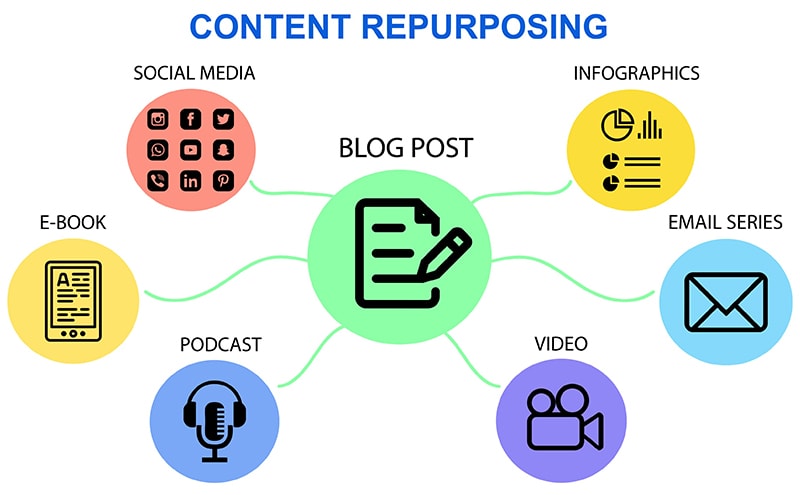Now, with a technologically steadfast yet functionally well-structured website and an architecture in place, which is oriented toward the best user experience, it is the time to go about developing an effective content strategy that attracts your target audience and converts them to whatever may be the desired end.
In other words, perhaps one has delved into the realms of keyword analysis and competitive research, and harnessed that precious insight to pilot the next moves.
Refreshing an existing content strategy or starting from scratch, foundation the effort through a widely accepted business innovation framework that addresses elements such as People, Technology and Process.

People
The concept of “People” involves focusing on two primary categories: those spearheading your content endeavours and your targeted audience and clientele. Who will take charge of your company’s content initiatives?
In smaller e-commerce setups, your Managing Editor and Content Marketing Manager or Content Director might be a single individual, whereas in mid-sized to large enterprises, you’ll probably require separate roles for each.
Guiding the best content marketing team requires acute attention to detail, exceptional copywriting and editing capabilities, and the aptitude of a journalist to uncover, assess, and succinctly summarize occasionally intricate information and data.
It is now of utmost importance that content marketing leaders are well-versed in the realm of martech and comprehend its potential for advancing your e-commerce objectives.
It may not be strictly necessary to look for someone who already has deep experience with your company’s particular configuration of the technology stack or platform.
Considering hundreds of different martech tools out in the market today, it is more about hiring a leader who can learn fast about your selected technologies and tools.
Complemented by an analytical mindset that is sharp as a tack, your ideal content marketing manager should bring creativity and effective communication in equal measure.
This role is not only about communicating content marketing successes within an organization but also serving as an advisor and partner to other internal stakeholders.
Their charter is to ensure the content strategy reflects and represents the needs and interests of operations, product development, sales, and other functional groups.
Besides that, you also let this person motivate and lead a possibly big content team, including a broad variety of creative and analytic talent. A candidate for a leadership role in content marketing should already have experience leading teams to meet specific business goals.
In the case of bigger brands, this may be a strategic reason to go with a Content Strategist. When hiring a strategist, find one who understands not only the basics of great content but also has a high-level understanding of what is going on with search and content discovery.
This will be the individual who ensures your content efforts align with the broader objectives of your company. He or she should be exceedingly conversant with your brand and keenly aware of what your specific e-commerce audience needs to understand and engage.
Building Your Content Team
Whom should you hire onto your team, and in any case, what key roles do you want to make sure are covered? It very much depends on the size of your brand as to whether you’ll have one team member managing a number of areas of responsibility, or vice versa-you may well have several team members focusing on one area.
You might want to leverage freelancers for specific projects, or even outsource to an agency that can handle your content on your behalf.
Regardless of your approach, it is imperative that these critical functions within your content marketing operation are accounted for:
- Content creation encompasses tasks such as writing, photography, graphic design, video editing, and more.
- Editing, with a particular focus on maintaining brand voice, optimizing content for search engines, aligning with the customer journey, and adapting the format for specific channels.
- Attention is paid to project management so that workflow is maximally efficient.
- Content promotion, via public relations or paid channels.
Your Ideal Audience
Personal development and customer journey mapping are key parts of any holistic content strategy. These are not static exercises but rather living guidelines that you will refer to regularly and update in light of performance data.
Persona Development
Personas serve to enlighten you about:
- The individuals you seek to engage with.
- The problems you can address for them.
- Where you can locate them online.
- How to communicate effectively with them.
These personas play an important role in content planning, helping you identify gaps and opportunities. Furthermore, your content creators will rely on them to gain a deeper understanding of the audience they are striving to reach.
Customer Journey Mapping
You can use Avinash Kaushik’s “See, Think, Do, Care” customer journey framework, particularly as an e-commerce alternative to conventional linear models. In this framework, audience segments are delineated by their behaviours rather than demographics or psychographics:
- See: The broadest qualified audience accessible to you.
- Think: Your most extensive addressable qualified audience exhibiting some commercial interest.
- Do: Your largest addressable qualified audience displaying substantial commercial intent.
- Care: Current customers, defined by having completed two commercial transactions.
Every piece of content should fulfil a specific need for your target audience, whether that need is informational, navigational, or transactional in nature. Integrating content mapping into your customer’s journey is a vital tactic to include in your ongoing content planning.
Additionally, there is substantial value in applying this approach retrospectively to your existing content inventory through a content audit. This can be challenging for companies that have already generated a substantial volume of content before implementing a defined content strategy.
Mapping your existing content can help identify valuable opportunities to refresh or re-release your top-performing content. It can also shed light on content gaps that you can address in new content development.
Prepare Your Team for Success in Content Marketing
Once you have the right team to present your business and products to eager consumers at crucial junctures, the responsibility lies with you to guarantee they possess the necessary resources for execution.
In 2022, the most effective B2C brands in content marketing allocate 26% of the entire marketing budget to content marketing. A steadily growing share of that is invested in technology and tools that empower marketers to successfully create, optimize, and distribute content.
Technology
State-of-the-art technologies, especially those embedding AI or machine learning components, open exciting opportunities for ecommerce companies that want to personalize their content and connect with prospective customers in a more valuable way.
Here are some considerations that will help you choose the right technology to power your content strategy.
Stack or Suite?
The total number of digital technologies used in content marketing by an average B2C company is about. Analytics tools and email software top this list. But a big shift is underway.
The true potential of AI becomes more evident when the insights generated by one tool can seamlessly benefit another.
As a result, marketing leaders are discovering that the need for disconnected datasets and manual workarounds hinders the performance of their content marketing efforts.
Today, organizations have the capability to deploy comprehensive suites of interconnected tools. These suites may encompass various functions within your content marketing strategy, or content may serve as just one component of a broader and integrated platform.
Intelligent Automation
We have used automation over the years for routine tasks to make them more efficient, including keyword and competitive research, to conserve man-hours.
Out of the progress with AI, we’ve moved a good deal beyond basic automation to intelligent automation. In that space, our technologies are doing more than completing tasks, but also optimization, prioritization of tasks, and making decisions all by themselves. Automation will require a person to feed in the correct data and commands for it to carry out a task to completion.
In contrast, intelligent automation empowers us to input vast amounts of unstructured data into systems, which then analyze and activate this information. As an illustration, early content tools automated the calculation of keyword density, which has become an obsolete metric today. Now, intelligent automation can:
- Analyze search data and on-site consumer behaviour.
- Identify content gaps in the customer journey.
- Generate content to fill those gaps.
- Target this content to searchers who exhibit similar future behaviour.
It is important to define precisely what you expect your content marketing technology to achieve and establish metrics for evaluating the outcomes of these endeavours.
Who is Responsible for Your Content Marketing Technology?
Effectively harnessing any technology necessitates a profound comprehension of its inner workings by the person operating it. Nevertheless, in the realm of content marketing, creative and interpersonal abilities hold equal significance.
The pivotal question is, who bears the ultimate responsibility for deploying, managing, and ensuring the success of your content marketing technology? This may be a responsibility of the Content Marketing Manager for smaller organizations.
For larger e-commerce organizations, it may be prudent to create a well-defined and distinct role within the organization for martech management-or even as a separate role from content marketing management.
Whoever’s in this role needs to understand your business goals inside and out, and on a deep level, understand how your technology supports and furthers these goals.
Process
With your team in place and equipped with the appropriate technologies, ensure that you incorporate a scalable process into your e-commerce content marketing workflow.
Roles and Workflow
Defining roles takes time, but it saves you from redundancies and conflicts in your content workflow. That means you create a list of tasks as responsibilities for each team member. With that list of tasks, you’ll stipulate the business and marketing outcomes for which each is responsible.
Considerations include:
- What approvals and permissions are required prior to content going live? Who is responsible for obtaining permission and then advancing each piece of content through the process?
- Which team members have access to specific technology tools, and what are the expectations for their use in performing their respective duties?
- How is reporting managed, and who is tasked with sharing successes and opportunities with the rest of the team?
- How frequently will team meetings occur, and who needs to participate in them?
- How are team members expected to collaborate and communicate, and what measures can be put in place to facilitate these processes?
- Do content team members have open access to internal stakeholders whose knowledge is essential for creating authentic content?
- Likewise, how does your content team engage with operations, sales, R&D, and other stakeholders?
Editorial Calendar
Your Editorial Calendar serves as a dynamic roadmap for your e-commerce company’s content endeavours, and every team member should have access to it, even if it’s just in a view-only mode.
Google Sheets is an excellent choice for this purpose unless your comprehensive marketing suite already uses an editorial calendar feature.
Ideally, your Editorial Calendar should encompass:
- Content concepts and ideas.
- Approved content concepts ready for development.
- The objective of each piece.
- The designated channel for publishing each piece.
- Channel-specific details (e.g., subject line and audience segment for emails, categories and tags for blogs, etc.).
- Content creators’ responsibilities.
- Required research and information for each piece.
- Supplementary content, background information, and references.
- Calls to action.
- Approval prerequisites.
- Target dates for submission and publication.
- Updates on status and progress.
For optimal results, assign one team member as the custodian of the calendar, typically your Managing Editor or the individual responsible for this role. This person’s duty is to keep the calendar current as each piece advances through your company’s workflow.
Content Inventory
Your content inventory can exist as a separate tab within your Editorial Calendar or as a distinct document on its own. Constructing a content inventory can prove challenging, particularly if you’ve been publishing for an extended period and have amassed a substantial volume of undocumented content. However, the effort is undoubtedly worthwhile.
In your content inventory, you should meticulously record the following details for each piece:
- Name or title.
- URL, if it possesses a permanent address, or a draft URL if it doesn’t.
- Relevant topic, broad category, or association with a product/service.
- Publication or distribution date.
- Significant metrics (such as annual or monthly pageviews, search visibility, conversions to specific actions, etc.).
During your content meetings, refer to the content inventory as you plan new pieces. Consider:
- Opportunities to refresh existing content that is still performing well, rather than commencing from scratch.
- Utilizing pieces from your existing inventory to complement new content through internal linking strategies.
Final Thought
Content strategy is complex, yet hugely important to pin down. Of course, it’s great to write down your goals, but you need an actual strategy that will guide and shape your efforts from top to bottom. Not only does such a strategy keep your team members aligned and focused, but it can also be referred to in justification of an action or decision made in support of it.
After all, writing out a strategy doesn’t mean it’s set in stone. In fact, the most successful content strategies revisit and revise periodically based on the results they see.










